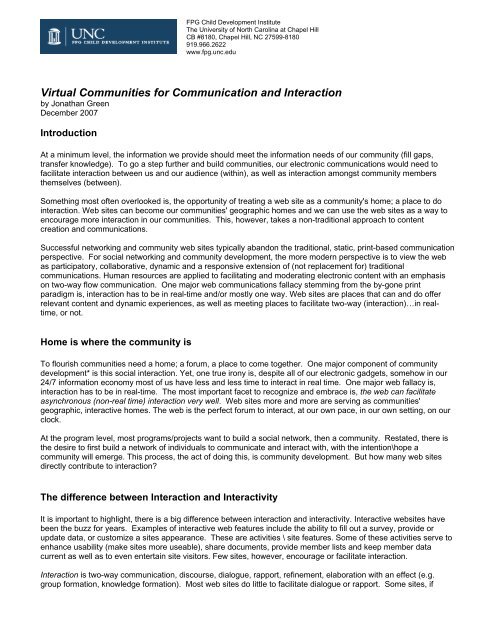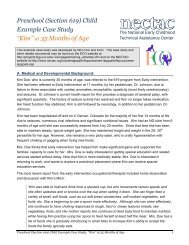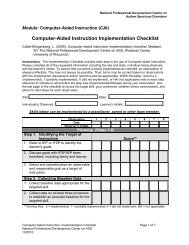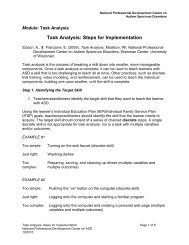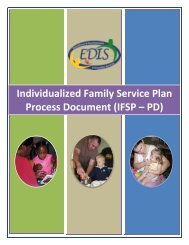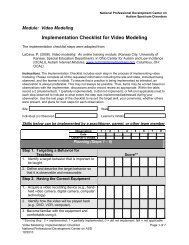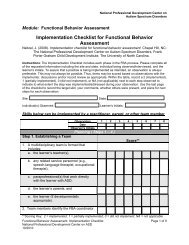Virtual Communities for Communication and Interaction
Virtual Communities for Communication and Interaction
Virtual Communities for Communication and Interaction
Create successful ePaper yourself
Turn your PDF publications into a flip-book with our unique Google optimized e-Paper software.
FPG Child Development InstituteThe University of North Carolina at Chapel HillCB #8180, Chapel Hill, NC 27599-8180919.966.2622www.fpg.unc.edu<strong>Virtual</strong> <strong>Communities</strong> <strong>for</strong> <strong>Communication</strong> <strong>and</strong> <strong>Interaction</strong>by Jonathan GreenDecember 2007IntroductionAt a minimum level, the in<strong>for</strong>mation we provide should meet the in<strong>for</strong>mation needs of our community (fill gaps,transfer knowledge). To go a step further <strong>and</strong> build communities, our electronic communications would need tofacilitate interaction between us <strong>and</strong> our audience (within), as well as interaction amongst community membersthemselves (between).Something most often overlooked is, the opportunity of treating a web site as a community's home; a place to dointeraction. Web sites can become our communities' geographic homes <strong>and</strong> we can use the web sites as a way toencourage more interaction in our communities. This, however, takes a non-traditional approach to contentcreation <strong>and</strong> communications.Successful networking <strong>and</strong> community web sites typically ab<strong>and</strong>on the traditional, static, print-based communicationperspective. For social networking <strong>and</strong> community development, the more modern perspective is to view the webas participatory, collaborative, dynamic <strong>and</strong> a responsive extension of (not replacement <strong>for</strong>) traditionalcommunications. Human resources are applied to facilitating <strong>and</strong> moderating electronic content with an emphasison two-way flow communication. One major web communications fallacy stemming from the by-gone printparadigm is, interaction has to be in real-time <strong>and</strong>/or mostly one way. Web sites are places that can <strong>and</strong> do offerrelevant content <strong>and</strong> dynamic experiences, as well as meeting places to facilitate two-way (interaction)…in realtime,or not.Home is where the community isTo flourish communities need a home; a <strong>for</strong>um, a place to come together. One major component of communitydevelopment* is this social interaction. Yet, one true irony is, despite all of our electronic gadgets, somehow in our24/7 in<strong>for</strong>mation economy most of us have less <strong>and</strong> less time to interact in real time. One major web fallacy is,interaction has to be in real-time. The most important facet to recognize <strong>and</strong> embrace is, the web can facilitateasynchronous (non-real time) interaction very well. Web sites more <strong>and</strong> more are serving as communities'geographic, interactive homes. The web is the perfect <strong>for</strong>um to interact, at our own pace, in our own setting, on ourclock.At the program level, most programs/projects want to build a social network, then a community. Restated, there isthe desire to first build a network of individuals to communicate <strong>and</strong> interact with, with the intention\hope acommunity will emerge. This process, the act of doing this, is community development. But how many web sitesdirectly contribute to interaction?The difference between <strong>Interaction</strong> <strong>and</strong> InteractivityIt is important to highlight, there is a big difference between interaction <strong>and</strong> interactivity. Interactive websites havebeen the buzz <strong>for</strong> years. Examples of interactive web features include the ability to fill out a survey, provide orupdate data, or customize a sites appearance. These are activities \ site features. Some of these activities serve toenhance usability (make sites more useable), share documents, provide member lists <strong>and</strong> keep member datacurrent as well as to even entertain site visitors. Few sites, however, encourage or facilitate interaction.<strong>Interaction</strong> is two-way communication, discourse, dialogue, rapport, refinement, elaboration with an effect (e.g.group <strong>for</strong>mation, knowledge <strong>for</strong>mation). Most web sites do little to facilitate dialogue or rapport. Some sites, if
somewhat progressive, have activities (interactivity), but few have a two-way communication flow (interaction) orhave a purposeful, plan full effect.Tools <strong>and</strong> Techniques<strong>Virtual</strong> <strong>Communities</strong> (VCs) are emerging as the way to do web interaction. VCs use a variety of tools <strong>and</strong>techniques to facilitate interaction. Some examples include:Tools that enable interaction• Webinars - where community members are able to dialogue (not just be talked to or be given simple Q&Atime).• Blogs - or other content where persons are able to post subject matter <strong>and</strong> add comments to existingsubject matter.• Wikis - where the community is able to build collaborative content• Other technologies - that encourage a two-way flow of communication.Techniques that facilitate interaction• Tagging - assigning keywords, indexing to site content.• Social Bookmarking – facilitating shared bookmarks.• Document management - enabling document storage, search <strong>and</strong> retrieval on the site.• Knowledge management – instilling a creation, capture, retention <strong>and</strong> access process.• Integration – providing easy ways <strong>for</strong> persons to subscribe <strong>and</strong> interact with site content via email.• Versioning <strong>and</strong> Repurposing – writing once, using anywhere.• Alerts – in<strong>for</strong>ming when new content is posted or old content is updated.• Directories – enabling live editing of personal in<strong>for</strong>mation.• Feeds – enabling subscription <strong>and</strong> un-subscription.• Content Rating – enabling user comments <strong>and</strong> ratings.Not only, do VCs employ novel tools <strong>and</strong> techniques, but the communication process itself is reconfigured.Emphasis is placed on creating content on various plat<strong>for</strong>ms (email, web, phone, print, presentations) that is notonly complimentary but drives traffic to the community. Every message is approached with the questions: How isthis going to bring people to the <strong>for</strong>um? What then do we want to happen?So the web in the traditional sense is a place to park web versions of content; repurposed content on a differentchannel. In a VC sense, the web is the place to do interaction, not just read.Now, the obvious question here is, how in the world would we get people to participate in interaction-type things?None of us have time, <strong>and</strong> with so many emerging technologies who has the time to keep up? How do we manageresources (e.g. development time) <strong>and</strong> risks (e.g. little or no participation)?The Way ForwardFact: About 90% of the web in<strong>for</strong>mation I have ever deployed on any web site has been unresponsive, untargeted<strong>and</strong> in the "about us" category (the project, it's people, it's activity in the singular). Very little has ever facilitated anyinteraction or whatsoever.To move <strong>for</strong>ward, to engage network members <strong>and</strong> build community, projects need to think more "about them" <strong>and</strong>"about us" in the plural. To do <strong>Virtual</strong> Community development, all electronic content creation must be realigned toa community perspective; emphasis must be placed on facilitating interaction. Thought must be given to howcommunications tactics (different mediums, different timings) overlap <strong>and</strong> can all be working to facilitate interaction(two-way flow) between the project <strong>and</strong> the project community, as well as between community membersthemselves. For example: Is there a way to use the web to continue dialogue from a meeting? Is there a way toenable community persons to use the project web in their own discussion?
There are literally hundreds of web interactivities to deploy, but very few that actually facilitate interaction. Why?<strong>Interaction</strong> is people, not technology, <strong>and</strong> managing interaction requires dedicated people.<strong>Virtual</strong> Community RolesRegardless of whether fulltime people are devoted to managing a <strong>Virtual</strong> Community, an underst<strong>and</strong>ing of variouscommunity roles is necessary to do/facilitate electronic interaction <strong>and</strong> build online communities.ExpertsExperts are the knowledge entrepreneurs. They are persons who spend most of their time analyzing, synthesizing,reflecting, <strong>and</strong> exp<strong>and</strong>ing on data, in<strong>for</strong>mation <strong>and</strong> group communication. They have no preferred communicationmedia because knowledge can be created anywhere. Their tech savvyness may or may not be limited, but theirnumber one constraint is time (based on the dem<strong>and</strong>s of the knowledge creation process itself). They work closelywith Content Creators to communicate their messages.Due to the elongated process of knowledge creation, experts are typically slow to adopt new tools.Content CreatorsContent Creators are persons who assimilate, filter, analyze <strong>and</strong> interpret in<strong>for</strong>mation (e.g. “mash up” or“synthesize”) as well as create <strong>and</strong> transmit communications. This is not restricted to creating web content. Theirmost valuable role is the ability to repurpose content; create email, web, presentation, print, <strong>and</strong> other versions ofcontent <strong>and</strong> ensure are all complimentary. Content Creators work with content contributors <strong>and</strong> experts to interpret<strong>and</strong> write messages that can be received, read <strong>and</strong> understood by all community members.Content Creators <strong>and</strong> are typically quick to adopt tools that speed their interpreting <strong>and</strong> production steps.Content ContributorsContent Contributors are persons who contribute content (data, in<strong>for</strong>mation, feedback) but are not tasked withversioning <strong>and</strong>/or distributing it. They are usually not interested in <strong>for</strong>mally creating content. They merely want totalk, either provide in<strong>for</strong>mation <strong>and</strong>/or feedback. They are very important to providing the critical mass that leads tobroad discussion <strong>and</strong> idea creation in a <strong>Virtual</strong> Community.Content Contributors will adopt a new tool only if it is very easy to use <strong>and</strong> integrates with exiting behavior.LurkersLurkers are persons that visit online communities <strong>and</strong> rarely, if ever, participate in any dialog or exchange. Lurkerstypically make up the largest portion of online communities <strong>and</strong> their active browsing\visitation\membership thoughinactive participation has various motivations (Hester: 2006). Motivating them is key to knowledge <strong>for</strong>mation. Eventhough they are not visibly active, their role in reading/observing community activity is valuable in to thedissemination <strong>and</strong> knowledge transfer process.Lurkers use tools to gain visibility to community activity <strong>and</strong> content. Tools typically do not motivate lurkers toactually participate in VCs as their motivations <strong>for</strong> participation vary.IT Programmers/DevelopersIT Programmer\Developers work with the community to enable interaction via technology. They develop, deploy<strong>and</strong> mange tools that facilitate the Content Creator <strong>and</strong> Contributor, tasks. They work closely with the CommunityDeveloper to underst<strong>and</strong> existing <strong>and</strong> emergent group behavior <strong>and</strong> automate routines to facilitate group activity<strong>and</strong> interaction.IT Programmers develop <strong>and</strong> deploy tools, but typically do not create content or monitor use.Community DeveloperThe role of the web community developer is nothing new. AOL has been developing online communities (e.g.health) <strong>and</strong> had persons managing them since the advent of the web browser. In mainstream web terms however,the role of online community developer is an emerging one. Web community developers are not just the personswho manage content, but persons whom manage <strong>and</strong> facilitate online interaction. This role is a complete drift fromtraditional IT developers\managers (tech orientation) <strong>and</strong> communications staff (in<strong>for</strong>mation <strong>and</strong> communications
orientation). At a strategic level, the Community Developer promotes the web site (virtual community) as theproject’s home <strong>and</strong> redirects content creation <strong>and</strong> communication ef<strong>for</strong>ts toward making the web site as THE placeto do interaction. Community developers motivate the activity <strong>and</strong> interaction of members.Community Developers are responsible <strong>for</strong> facilitating <strong>and</strong> managing/monitoring interaction, including usage ofvirtual community content, tools <strong>and</strong> techniques <strong>and</strong> making recommendations <strong>for</strong> enhancements.ModeratorAt a tactical level, the moderator ensures that the web site remains a place that is participatory, collaborative,dynamic <strong>and</strong> most of all, responsive; timely responding to discussion posts, in<strong>for</strong>mation requests <strong>and</strong> feedback aswell as working with content creators to synthesize group interaction into virtual community content. Moderatorsbuild trust. Trust takes time. Sharing typically does not occur until trust is established. Along with communitydevelopers, moderators motivate the activity <strong>and</strong> interaction of members. They also participate in the activity <strong>and</strong>interaction.Moderators are responsible <strong>for</strong> using tools <strong>and</strong> encouraging tool use on a day to day basis.Closing RemarksIf our goal is to do community development, then after gauging our audience (their availability, capability, interests,in<strong>for</strong>mation gaps, etc.), <strong>and</strong> considering the difference between interactivity <strong>and</strong> interaction, all our content creationef<strong>for</strong>ts should be more focused on facilitating more web interaction. Why this is not done more is a carry over fromthe print paradigm; a paradigm where interaction with a piece of paper is either not possible or is not timely.As we allocate resources to creating content <strong>for</strong> the coming months <strong>and</strong> years, we need to look beyond simpleinteractivity <strong>and</strong> focus on interaction; steadily <strong>and</strong> purposefully building that steady flow of up- <strong>and</strong> down- streamweb communication; a message, a response, a follow-up response, etc. The web is a responsive media.We can leverage technologies <strong>and</strong> use them to facilitate more electronic interaction; but at its root, interaction isbetween people, not technology.Our human resources should be reallocated to creating <strong>and</strong> managing web content that facilitates more interaction.All media should be seen <strong>and</strong> used as complimentary, with the web serving as the project’s home <strong>and</strong> a place to dointeraction.Closing Quotes“Whether face-to-face or virtual, a community of like-minded people creates belonging, trust, passion,learning <strong>and</strong> relationships all of which fuel per<strong>for</strong>mance, motivation <strong>and</strong> ingenuity. In the knowledgeworkplace, community gains momentum as people gravitate toward work, ideas <strong>and</strong> in<strong>for</strong>mal groups thatenrich them intellectually, hasten their learning <strong>and</strong> keep them sharp. Equally important, as knowledgeworkers move wherever their brainpower takes them, they will seek identity, purpose <strong>and</strong> belonging notfrom corporate logos or organizational alignment but rather from communities of meaning.”- Diane Morello, Gartner“The value chains of in<strong>for</strong>mation that flow through multiple organizations create communities, groups ofcommon interest that may or may not cross (organizational) boundaries, but need to share in<strong>for</strong>mation <strong>and</strong>knowledge.”- John Ladley, Meta Group, Stan<strong>for</strong>d
References <strong>and</strong> ReadingsDrakos, N. (2006). A Blend of Wikis, Blogs <strong>and</strong> Discussion Forums Can Support Collaborative Business Activities.Gartner. G00143670.Eid, T., Drakos, N. (July 23 2007). The Emerging Enterprise Social Software Marketplace. Gartner. G00149899.Gordon, R. (2006). Online communities can build engagement, but require a plan. Readership Institute. Availableat: http://www.readership.org/blog2/2006/10/online-communities-can-build.htmlMorello. D. (July 6 2001). Make No Mistake: <strong>Communities</strong> Are About People. Gartner. SPA-14-0191.Hanna-Kaisa, E., Kosonen, M., Henttonen, K. (2007). The Development of a Sense of <strong>Virtual</strong> Community.International Journal of Web Based <strong>Communities</strong>. Vol. 3, No.1 pp. 114 – 130.Harris, K. (1999). The Knowledge Community: KM Success Waiting to Happen. Gartner. G-08-3402.Madanmohan, T.R., Navelkar, S. (2004). Roles <strong>and</strong> Knowledge Management in Online Technology <strong>Communities</strong>:An Ethnography Study. International Journal of Web Based <strong>Communities</strong>. Vol. 1, No.1 pp. 71 – 89.Inmon, W. H., Imhoff C., Sousa, R. (2000). The Corporate In<strong>for</strong>mation Factory. Wiley. 2nd Edition. ISBN0471399612.McHarg, J., McLachlan, J. C. (2006). Can Forming a <strong>Virtual</strong> Learning Community Enhance Learning on a Face-to-Face Learning Programme? International Journal of Web Based <strong>Communities</strong>. Vol. 2, No.4 pp. 447 – 45.Sampson, D. (2006). Enhancing Educational Portals Through Capturing Collective Knowledge of Web-basedLearning <strong>Communities</strong>. International Journal of Web Based <strong>Communities</strong>. Vol. 2, No.3 pp. 260 – 272.Wikipedia. (2007, September). Community. Available at: http://en.wikipedia.org/wiki/CommunityThis paper was initially prepared in September 2007 to facilitate discussion about <strong>Virtual</strong> <strong>Communities</strong>, KnowledgeManagement <strong>and</strong> Portals. It is work in progress <strong>and</strong> your comments are invited. The most recent version as wellas discussion can be found at:http://www1.fpg.unc.edu/community/knowledge-mobilization/Jonathan GreenITS Web ServicesFPG Child Development InstituteUniversity of North Carolina at Chapel HillCB # 8185Chapel Hill, NC 27599-8185phone: (919) 843-8743email: jonathan_green@unc.edu


